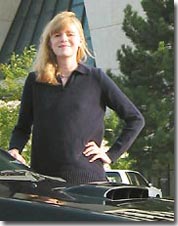Sam Zeller

Sam Zeller at the autocross
When Sam Zeller was in high school, some of the boys in one of her science classes put frog guts in her purse.
“That’s why I don’t carry a purse to this day,” Zeller said. “And also why I wasn’t terribly enthused about science.”
Growing up in suburban Glenview, just north of Chicago, Zeller was enrolled in a humanities program at her high school. She thought science and math were boring, and the teasing she endured—“stupid, immature high school stuff”—as one of the few females in her science classes didn’t help.
But during her senior year, “I had this really fabulous physics teacher, Mr. Lewis. Before, science had been really dull, but he was great. We did lots of labs, we built rockets.”And they went on a field trip to Fermilab, about 30 miles west of Chicago, home to the world’s most powerful particle accelerator. Scientists come from around the world to conduct basic research in order to understand the universe—what it’s made of, how it got here, and what’s going to happen to it.
“Fermilab was certainly not boring,” said Zeller. “It was a very busy place. There were lots of people bustling around, lots of cars in the parking lot, and it seemed like a very active, high-paced place. I was like, ‘Wow, this is real science.’”
Today, at 30, Zeller is still at Fermilab. She is currently on the staff at Columbia University as a postdoctoral researcher, but works full-time as a neutrino physicist on the MiniBooNE experiment. The neutrinos Zeller studies are fundamental particles, similar to electrons, that were long thought to have no mass at all. Recent work has overturned that theory, showing that neutrinos can morph from one type to another in a process called oscillation. MiniBooNE scientists are studying neutrinos by searching for those oscillations, which aren’t really as far-fetched as they sound.
If MiniBooNE sees an oscillation signal, it will have important consequences. The standard model of particle physics—the conceptual framework physicists use to describe all the fundamental particles, forces and interactions—will need substantial revising. One possibility, the easiest for the standard model to accommodate, is that a fourth type of neutrino will need to be written in (right now there are three).
MiniBooNE is currently taking data, which means that Zeller doesn’t have very much free time. Much of the spare time she does find, she spends on her car, a 2002 Subaru WRX station wagon that she bought herself last year as a graduation present, after receiving her Ph.D. in physics from Northwestern University.
“I’ve always liked cars, ever since I was little,” Zeller said. “My parents used to pick on me because I was always washing or waxing someone’s car on the weekends. Now I wax my car every weekend.”
She also sometimes participates in Autocross races, which take place every weekend during the summer. Venues such as the Chicago Motor Speedway set up cones in the parking lot, and drivers do time trials, competing to see who can make it through the course fastest.
“It’s a good way to work out stress and aggression,” Zeller said. She started watching the races last year after she was tipped off by some friends at Fermilab, and now she occasionally participates in the racing. “But I stink,” she said, laughing.
In the future, she hopes to improve her times on the race track—maybe even win a race—and continue working with neutrinos.
“I like neutrinos a lot,” she said, “and I like small collaborations, so I could see myself doing this. The future’s sort of uncertain, and I don’t know exactly what I’ll be doing, but hopefully it will be neutrinos.”











